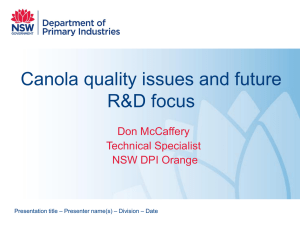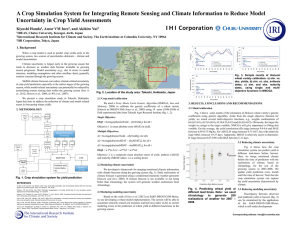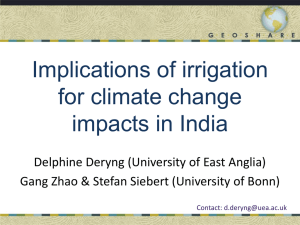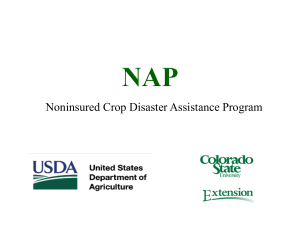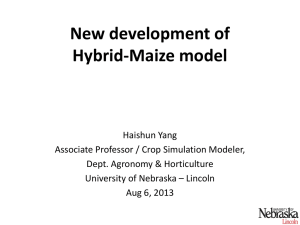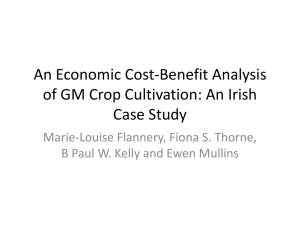YIELD FORECASTING_PRETORIA_FINAL
advertisement
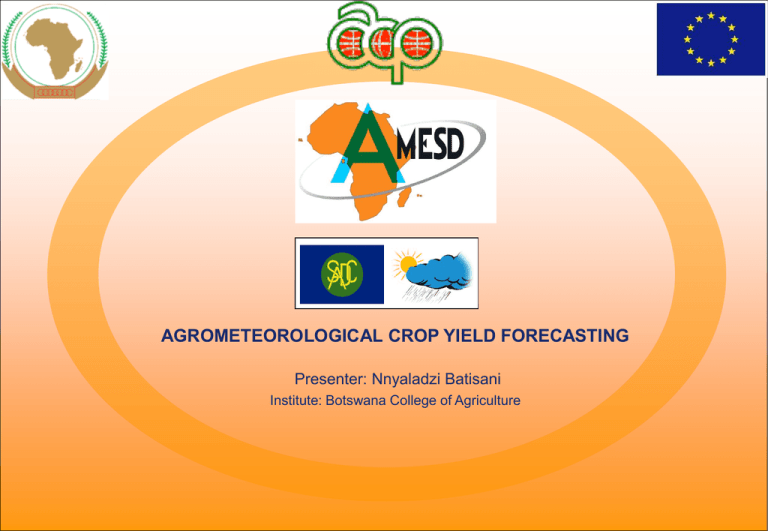
AGROMETEOROLOGICAL CROP YIELD FORECASTING Presenter: Nnyaladzi Batisani Institute: Botswana College of Agriculture • Crop yield forecasting provides a quantitative estimate of the expected crop yield over a given area. in advance of the harvest and in a way that constitutes an improvement over trends, provided no extreme conditions occur. (climate change induced increase in frequency of extreme events!) • It is based on the assumption that weather conditions are the main factor behind the inter-annual (short-term) variations of crop yields. • Thus quantitatively assesses the effect of weather fluctuations on regional crop yields before harvest. • Variations affecting yields are often termed “random” • Therefore yield forecasting methods can reduce the random component by taking advantage of both (i) the knowledge of the direct and indirect mechanisms governing plant-weather interactions and (ii) the fact that, although they are largely unpredictable beyond a week or so, weather fluctuations are not random (they follow known patterns). • • • • Yield forecasting methods include descriptive, regression and crop simulation Descriptive methods simply classify weather conditions, according to one or several variables, to identify conventional thresholds separating groups of significantly different yields. Regression methods derive equations relating crop yield with weather variables Simulation methods the most complex ones currently in use, attempt to analytically describe the physical and physiological impact of environment and management conditions on crop development, growth and yield. • The simplest descriptive methods are those that involve one or two thresholds. • It is sufficient to identify the environmental (agrometeorological) variables that are relevant for the crop under consideration. • This identification is normally done with statistical clustering analysis on a combination of time-series and cross-sectional data. • Once groups have been identified, it must be verified that yield averages corresponding to different clusters significantly differ from each other. • One of the reasons simple descriptive methods can be very powerful is that climate variables do not vary independently and constitute a “complex”. • For instance, low cloudiness is associated with high solar radiation, low rainfall, high maximum temperatures and low minimum temperatures. • Each of the variables affects crops in a specific way, but because they are correlated, there is also a typical combined effect, which the non-analytical descriptive methods can capture. • The descriptive methods have a number of advantages: (i) to start with, no assumption is made as to the type of functional relationship between the variables and the resulting yield; (ii) the clustering takes into account the fact that many climatological variables tend to be intercorrelated, which often creates methodological problems, at least with the regression methods; (iii) confidence intervals are easy to derive and, once developed, the descriptive methods require no data processing at all; their implementation is extremely straightforward. Regression methods Regression Methods • The simplest regression techniques rely on regression equations (mostly linear) between crop yield and one or more agrometeorological variables, for instance Yield (Tons/Ha) = 5 + 0.03*March rainfall (mm) – 0.10*June temperature (C) • Beyond their simplicity, the main advantage is the fact that calculations can be done manually, and in the fact that data requirements are limited. • The main disadvantages lie in the fact that they perform very poorly outside the range of values for which they have been calibrated. • They often also lead to unrealistic forecasts when care is not taken to give greater priority to the agronomic significance than to statistical significance. • Many of the disadvantages of the regression methods can be avoided when value- added variables are used instead of the raw agrometeorological variables. • Such a value added variable would be, for instance, actual crop evapotranspiration, a variable known to be linked directly with the amount of solar radiation absorbed by the plant under satisfactory water supply conditions. Crop simulation methods Crop simulation methods • Crop simulation methods are the most accurate and the most versatile in that they attempt to describe the crops behavior (physiology, development) as a function of environmental conditions. • They thus tend to be less sensitive to “new” situations that did not occur during the period used to “train” the model. • Typically, simulation models incorporate several components or sub-models: Phenology (or develop: the qualitative differentiation of plant organs into stems, leaves, flowers, etc.); Assimilation, i.e. the rate at which organic matter is synthesized; Partitioning and respiration, i.e. the way the organic matter is synthesized above is distributed between the plant organs; Root growth, i.e. the way roots explore a volume of soil from where water and nutrients are absorbed; Water management, essentially the way water infiltrates the soil, is absorbed by roots and is returned to the atmosphere either by transpiration through the crop or by evaporation from the soil; Nutrient management, the absorption of nutrients through roots and their distribution between plant organs. • A model run simulates the outcome (yield) of the plant-environment-management system for one set of model variables, environmental variables and management inputs. • Strictly speaking, this includes only a limited number of situations which could apply to one very specific field. • As the objective of yield forecasting is to estimate yield at the regional level, several techniques must be applied to convert the yield output by a model to regional averages. USING MODELS AS YIELD FORECASTING TOOLS • Crop simulation models provide an estimate of the likely yield as a function of the environmental and management conditions throughout the crop cycle (and before: soil moisture and soil fertility also depend on the conditions before the crop was sown). • However, when forecasting crops, only the conditions up to the time of the forecast are actually known. • It is thus necessary to provide the model with “future” data as well. • Two basic approaches can be adopted: (i) use of average (climatic normal) between the time of the forecast and harvest; (ii) use of the data from the N latest years on record in turn, which results in N yield estimates, the average of which (and the resulting confidence interval) are then assumed to constitute the envelope of the current year’s estimates. Particularly when models are used for short-term management decisions, the longest available forecast (roughly up to 10 days) is often inserted between the past observed data and the “future” data. However, this involves some methodological and practical difficulties which are hardly justified for most regional yield forecasts. • Instead of historical data, it is also possible to use synthetic time series provided by Random Weather Generators (RWG): • computer programmes which produce time series with the same statistical properties as the actual data. It is often believed that RWG series can help reduce the error affecting crop forecasts. • Finally, RWG can also produce sets of coherent climatic parameters (rainfall, temperatures, wind) on a spatial grid. • RWGs can also prove useful whenever the historical weather series are affected by a longterm trend, as in Sahelian rainfall from 1960 to 1984 (when the trend reverted and became positive). • It is clear that the historical data used in a forecast must be as recent and short as possible, to account for short-term fluctuations, but still long enough to retain statistical significance. • RWGs can be “trained” with the last ten years of data, then generate a much longer series (e.g. 50 years) to used in a forecast. • Most crop forecasts, regardless of the technology adapted, take only into account the direct environmental factors. • This means that the effect of large scale pest attacks, for instance, must be assessed separately. • In sum, Agrometeorological Crop Yield Forecasting (ACYF) approaches differ widely in terms of input data requirements and model complexity, resulting in very variable robustness, development and implementation costs. • The main advantage of ACYF methods is that they do provide objective estimates of regional yields in advance of the harvest, and at the fraction of the cost of sampling techniques. • As such, they constitute essential decision making tools. • “Robustness” appears to be the main practical criterion under most circumstances (more so than accuracy). • In fact, a method that performs well (accurately) under average conditions is easy to develop, but not very useful. • It is observed again and again that sophisticated crop simulation systems fail to forecast a yield increase or a drop due to a period of dry and sunny weather at an unusual time of the crop cycle, or rather “obvious” adverse factors such as excessively wet summer conditions. • It is suggested that this failure is a side effect of the complexity of the models with many components and many inputs: the forecasting method becomes too insensitive to individual inputs, particularly when the inputs have undergone very intensive pre-processing. • Traditional regression models with agrometeorological “independent” variables, on the other hand, often over-react due to their dependence on a too limited number of factors. REMOTE SENSING BASED YIELD FORECASTING • One of the key challenges for operational crop monitoring and yield forecasting using conventional methods is to find spatially representative meteorological input data. • Currently, weather inputs are often interpolated from low density networks of weather stations or derived from output from coarse numerical weather forecasting systems. • Given the importance of yield potential estimation and the limitations associated with these conventional methods of estimating it, there is need for continued innovation and evaluation of alternate techniques. • In particular, techniques that rely on timely readily available spatial explicit information such as Remote Sensing (RS) offer a solution to yield forecasting. • RS data acquired by satellite have a wide scope for agricultural applications owing to their synoptic and repetitive coverage. • Spectral indices deduced from visible and near-infrared remote-sensing data have been extensively used for: crop characterization, biomass estimation, and crop yield monitoring and forecasting. • RS data is qualitatively used as an independent source of information to confirm crop growth indicators as well as forecasts and identify area with anomalies. • This objective is realized through a series of products that are based on the comparison of various parameters for the current season with that of historical year, the previous year or exceptional years (e.g. absolute and relative differences, frequency analysis). Yield forecasting • Crop forecasts are typically issued between the time of planting and the time of harvest. • They use past data (data between planting or before, and the time of the forecast) and “future” data. • Future data can be implicit or explicit. • In the first case, the future is assumed to be “normal” whereas the second requires that numerical values be actually specified, for instance historical data or stochastic weather generator outputs • Some of the most widely used remotely sensed products for agricultural monitoring are precipitation, crop water requirements, and vegetation indices. • Precipitation is monitored primarily through the use of satellite-based rainfall estimates (RFEs) that augment the sparse observational network of rain gauge stations found in many developing countries. • RFEs provide daily estimates at a gridded cell size. • These data are useful for large area precipitation monitoring and are also used as inputs to crop performance models. • In order to provide information that can effectively be acted upon by the agricultural community, RS application must do more than simply monitor current conditions and report on growing season progress. • Thus dynamical long-range forecasts (three month) are imperative. • Operational crop yield forecasting is mostly achieved with empirical statistical regression equations relating regional yield with predictor variables, termed “factors”. • Regional yield (the “dependent variable”) refers to average yield over districts, provinces or, more rarely, whole countries; they are provided by national statistical services. • The factors can be any combination of raw environmental variables such as weather variables or indices, satellite indices such as NDVI. • Forecasts are used as analysis tools to analyze possible future changes in crop growth performance and climatic factors both which have a bearing on yield and ultimately food security implications. • Yield forecasting needs future data, i.e. an estimation of crop condition and performance based on indices such as NDVI, Rainfall Estimate (RFE), and Water Requirement between now, the time of the forecast, and the harvest. Verification of Crop Condition Monitoring and Yield Forecasting outputs Models: “Dirty crystal balls!” • Before models or any methods of monitoring and predicting crop condition and yield can be put to work in assisting with decisions in the real-world, • the user must be reasonably confident that the method or model describes actual responses to weather and management with a degree of precision that is sufficient for the intended application. • The standard wording usually resorted to in this context includes validation, calibration, and verification Calibration Calibration • Calibration and fine-tuning are the same concept. • Assuming that the author or the user of a model is satisfied with the algorithms, the next step is to submit the model or method to the ordeal by real-world data: the model is run repeatedly with actual inputs to see if it mimics reality sufficiently well. • The actual data are usually referred to as calibration data or training data. • The greater the variety of training data, the greater the chances that the model will be well behaved under new conditions. • In multiple regression models, calibration takes the meaning of finding the values of the coefficients that provide the best statistical fit to a set of experimental data (usually yields). • Within the limits of the models, rigorous methods exist to optimize the values of the coefficients • In all statistical calibration, one of the main problems is the proper balance between statistical and agronomic significance, essentially the orders of magnitude and the signs of the coefficients. Uncertainty analysis: reliability, accuracy, precision and bias Uncertainty analysis: reliability, accuracy, precision and bias • Uncertainty analysis deals mainly with model reliability, a term which encompasses both accuracy and precision. • A model output is accurate if in the long-term or under different conditions its average is close to the actual average; the difference between the averages is the bias. • A model is precise if there is little dispersion of the outputs. • Low accuracy is probably easier to correct than low precision; the former can be corrected through the identification of some error in the model variables or parameters. • Low precision is more difficult to tackle, as its source is more likely to be in the input data, including their selection, than in the model proper. • In fact, the accuracy-precision discussion is useful in that it allows some identification of the source of the errors. • It is a rather common observation that all models, tend to underestimate the variability present in actual cropping. • In other words: models tend to simulate average conditions more often than desired. • The more reason why monitoring can be better than sophisticated models! • Its important to note that there is no best method or approach • All methods (including RS) are better viewed as tools within a tool box; complementary in nature • Thus ground truthing (validation) is a prerequisite for adopting any RS based method for yield monitoring and forecasting Sensitivity analysis Sensitivity analysis • Sensitivity analysis examines the response of outputs to changes in the input data and in the model parameters. • A convenient way to approach sensitivity analysis is to plot both the output variable O and the input parameters P of interest as a percentage of their normal ranges: this immediately indicates the effective role of the parameter and the fact that other factors are at work. • When more than two parameters are chosen (P1 and P2), the same approach can be used. Model validation Model validation • This is the comparison of the forecasted yield with the actual yield obtained or the estimated crop condition and the actual condition in the field. • When everything has been said and done: RS based yield monitoring and forecasting will only be adopted if it adds value to current methods or is better They are easy to implement Not overloading users with products that are mostly highly correlated • Thus using a few products that are highly correlated to yield and/or rangeland condition and are easily obtained, for crop and rangeland condition monitoring seems feasible and practical. Yield Gap Analysis Yield Gap Analysis • Yield gap is the difference between the forecasted potential yield and actual on-farm production caused by the compounded constraints that confront a farmer such as water availability, diseases and pests • Assessment of potential yield and the yield gap between potential and actual yield is essential for food security planning and famine early warning systems. • Under rainfed situation water supply for crop production is not fully under the control of the grower, thus water-limiting yield may be considered as the maximum attainable yield for yield gap analysis assuming other factors are not limiting crop production. • However, there may be season-to-season variability in potential yield caused by weather variability, particularly rainfall. • Once the yield gap between actual and forecasted yield is determined, • Then major constraints and limitations causing the gap can be assessed in order to focus on the priority research or crop management needs to bridge the yield gap in an effort to alleviate famine and improve food security. • Future trajectories of food prices, food security, and cropland expansion are closely linked to future average crop yields. • Because the maximum possible yields achieved in farmers’ fields might level off or even decline in many regions over the next few decades, reducing the gap between average and potential yields is critical. • A fundamental constraint in these systems appears to be uncertainty in growing season weather; thus tools to address this uncertainty would likely reduce gaps. • Including improved yield monitoring and forecasting The END Thank You.

